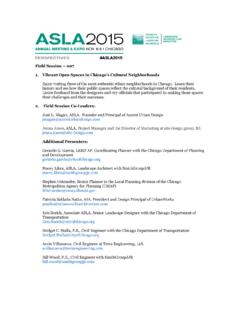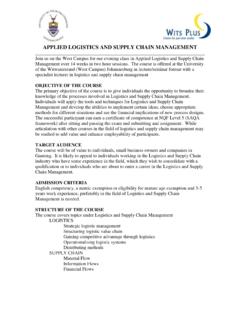Transcription of SMART CITIESHow 5G Can Help Become Vibrant Smart Cities
1 SMART CITIESHow 5G Can Help Municipalities Become Vibrant SMART CITIESHow 5G Can Help Municipalities Become Vibrant SMART CitiesExecutive Summary For decades, the evolution of communications technology has laid the foundation for broad economic growth across the United States benefitting towns and Cities large and small. The next generation of wireless network infrastructure will be built using small-cell networks employing 5G wireless technology. The connectivity and computing capacity unleashed by these high-speed wireless networks will bring the power of SMART City solutions to municipalities across the country. This can transform local economies. Research has suggested that SMART City solutions applied to the management of vehicle traffic and electrical grids could produce $160 billion in benefits and savings through reductions in energy usage, traffic congestion and fuel costs. These 5G attributes will enable Cities to reduce commute times, improve public safety and generate significant SMART grid efficiencies.
2 Beyond the benefits of pervasive SMART City technology, the potential gains from the deployment process for such technology are also significant since telecom operators are expected to invest approximately $275 billion in infrastructure, which could create up to 3 million jobs and boost GDP by $500 Economic ImpactsJobs CreatedGDP GrowthInvestment3 Million$500 Billion$275 BillionFull realization of the economic growth and cost savings from leveraging SMART City solutions built on 5G infrastructure will, however, depend on how robustly 5G networks are deployed locally, and will require different approaches from those used in the past. The network deployment build of 5G will involve 10 to 100 times more antenna locations than 4G or 3G. These cells are small the size of a shoe box and are critical not only for delivering the speed and capacity promised by this next generation of wireless, but also for supporting the increased number of devices that will be connected to the network in the 1To support the increased density of small cells that will be required to obtain both the economic and SMART City benefits enabled by 5G wireless networks, there are a number of steps municipal leaders should take to encourage telecom operators to invest in deploying next-generation infrastructure in their municipalities.
3 Today, many municipalities require approvals and fees based on the historical deployment of large towers that can be more than 250 feet tall. The shift from traditional large wireless towers to small-cell sites affixed on locations from lamp posts to utility poles will require a streamlining of the permitting process governing wireless infrastructure deployment and an appropriate adjustment in permit areas. If municipal and regulatory leaders wish to reap economic benefits, including jobs and GDP growth, and accelerate their journey to becoming a SMART City, they should strive to be among the first to streamline permitting, change their fee structures, and reduce regulatory hurdles to support the new small-cell deployment model required for this next generation of wireless technology. Saratoga, CA 29,900 $50M$20M$10M Jobs CreatedGDP GrowthNetwork InvestmentSmart Grid + Transportation Bene itsBeaumont, TX 118,000 ,000$180M$100M$70 MMetro Chicago, IL 9,472,000 ,000$14B$8B$5 BSmart City Technology & 5G Are Expected to Benefit All Community SizesPage 2 The Next Generation of Wireless Technology Will Fuel Economic Growth The full potential of SMART Cities will be unlocked by 5G networks and small cells, creating jobs as well as entire new industries.
4 Communities that support 5G wireless technology will see significant economic and community benefits. This next generation of wireless technology is expected to create 3 million new jobs and boost annual GDP by $500 billion, driven by a projected $275 billion investment from telecom operators. Direct Economic Benefits As telecom operators build out their networks, they are expected to invest across the country. Our analysis indicates that telecom operators could invest approximately $275 billion over seven years to deploy next-generation wireless technology, with trials beginning as early as 2017 in select Of that $275 billion, $93 billion is expected to be spent on construction, with the remainder being allocated for network equipment, engineering, and planning. 5G Economic ImpactsJobs CreatedGDP GrowthInvestment3 Million$500 Billion$275 BillionPage 3 Deploying the infrastructure required for 5G will also create jobs. We estimate that approximately 50,000 new construction jobs will be created each year over the 7-year buildout period.
5 When we consider the effects on suppliers and other partners, and their spending in the economy, the full impact from construction spending alone could be approximately 120,000 jobs created each year during the first seven years of Broader Economic BenefitsThough the direct jobs and investment to be expected from deploying 5G are significant, the broader economic benefits associated with an improved wireless communications network are even greater. Based on research into the benefits of adopting the next generation of wireless technology,3 we expect 5G could help create million jobs, and approximately $420 billion in annual GDP, spread across small, medium and large communities in the Another of 5G s contributions to generating jobs and economic growth will be providing the benefits of high-speed broadband to the 5% of Americans who currently do not have access. Because faster Internet connections allow users to utilize video applications for telecommuting, or participate in e-learning courses that give them additional skill sets or certifications, their employability and earning power increases, thus creating a more competitive workforce in different localities which would, in turn, attract higher-paying jobs to these communities.
6 If localities embrace 5G, and citizens who are not already online Become adopters, we could see an additional $90 billion in GDP, and 870,000 in job growth. Communities of all sizes are likely to see jobs created. Small to medium-sized Cities with a population of 30,000 to 100,000 could see 300 to 1,000 jobs created. In larger Cities like Chicago, we could see as many as 90,000 jobs , CA 29,900 $50M Jobs CreatedGDP GrowthBeaumont, TX 118,000 ,000$180 MMetro Chicago, IL 9,472,000 ,000$14B5G Is Expected to Benefit All Community SizesPage 4On a state level, there will also be significant economic benefits. Analyzing a sample of different-sized states across different regions, the number of jobs created in the short-term as a result of network deployment is expected to be significant for both large and small states, with California seeing more than 11,000 jobs created. State Network Increased Deployment CompetitivenessCalifornia 11,000 375,000 Florida 6,000 195,000 New York 5,000 190,000 Oregon 1,100 39,000 South Dakota 200 8,000 Expected Number of Jobs Created by StateWhile the deployment of 5G wireless networks will bring near-term economic benefits, it will also help to ensure that communities remain competitive over the longer term by allowing them to fully leverage SMART City technology, and ensuring the latest wireless communications technology is available to citizens and businesses.
7 The job impact for larger states could be considerable; California could see as many as 375,000 long-term jobs created. Page 5 SMART City Growth Will Be Accelerated by Next-Generation Wireless The SMART City applications currently leveraging today s wireless networks are already showing significant benefits to communities. Building on the foundation of 4G LTE, 5G will accelerate these SMART City benefits. The key attributes of 5G that will benefit SMART Cities include higher speeds; more connections thus enabling wireless connectivity in unprecedented locations, ranging from street lights to sewer holes; quicker, more adaptive response times that support time-sensitive applications, such as vehicle-to-vehicle communications; and ultra-low-power connections, such as sensors for leak detection in water mains, since, in many cases, the replacement cycle is directly related to battery life. We have picked three areas energy/utilities, transportation, and public safety to showcase what is possible when municipalities welcome next-generation wireless technology.
8 These examples also illustrate how wireless connectivity is already creating jobs, generating municipal efficiencies, and increasing government revenue. 5G: Technology to Meet the Growing Demands of SMART CitiesAbility to connect many more sensors and devicesHigh-speed ubiquitous connectivityPrioritization, greater reliability and redundancyUltra-low power consumptionPage 6 Energy & UtilitiesSmart Grid. 5G technology will help unleash the next wave of SMART Grid features and efficiency. Across the , SMART Grid benefits are estimated to be as high as $2 trillion dollars over 20 By allowing many unconnected, energy-consuming devices to be integrated into the grid through low-cost 5G connections, 5G enables these devices to be more accurately monitored to support better forecasting of energy needs. By connecting these energy-consuming devices using a SMART grid, demand-side management will be further enhanced to support load balancing, helping reduce electricity peaks and ultimately reduce energy costs.
9 Capturing this data through 5G connections will further enable larger Cities , or even state-level jurisdictions, to plan expensive energy infrastructure spending more efficiently and reduce downtime. In the event of power failure, SMART grid technology enables precise, real-time diagnosis, down to the specific pole or transformer affected by an outage, which speeds up repairs and reduces downtime. For example, by installing SMART grid technology, Chattanooga, TN, a medium-sized town, reduced the duration of outages by over 50% during a severe windstorm and saved the utility $ million* in operational costs for just one Last but not least, 5G is itself more cost effective and energy efficient than past generations of wireless technology, thus making its own contribution to energy Lighting. By automatically dimming public lighting when no pedestrians or vehicles are present, SMART lighting can save power and reduce light pollution while still keeping neighborhoods safe.
10 SMART lighting has begun to be rolled out in Cities such as San Diego and Barcelona7 as part of a larger SMART City initiative. Through its system, San Diego will save an estimated $ million8 annually through the installation of these street lights. Across the , the potential savings from this approach are estimated to be more than $1 billion per year. SMART lighting connected to a city s broadband network can also monitor local air quality. Adding this level of connectivity to SMART LED lighting can also reduce the lighting system s maintenance costs. Current SMART Grid sensors New 5G low-cost sensorsSmart Energy Grid5G enables additional low-cost connections to provide comprehensive coverage of the energy grid. $ *Million SavingsPage 7 TransportationBy leveraging next-generation wireless technology, communities can improve their transportation systems enhancing public transportation, reducing traffic congestion, and generating revenue from public parking efficiencies.















